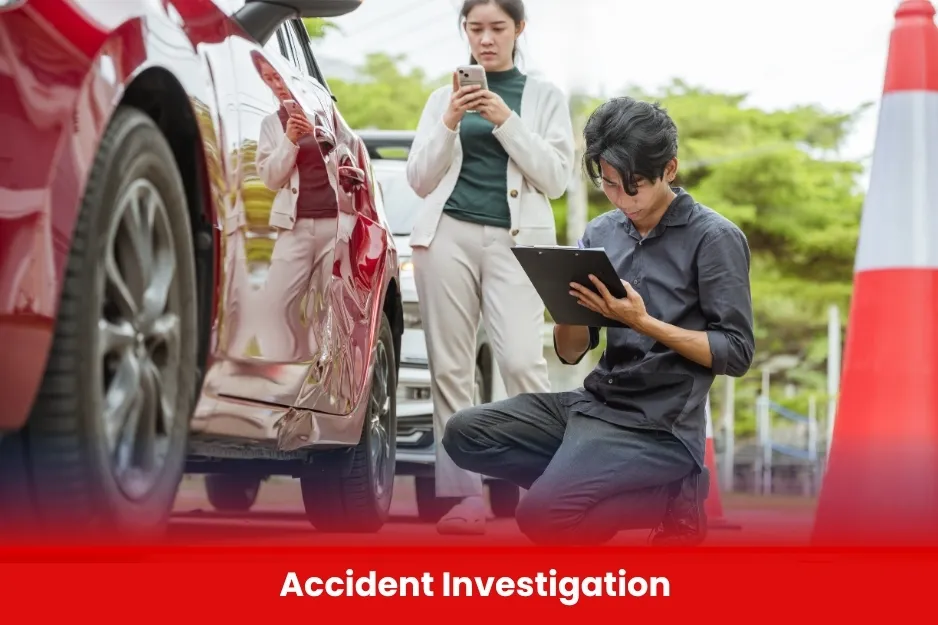Accident Investigation
At Buraaq UK, we are committed to maintaining a safe and healthy working environment for all employees, contractors, and visitors. Despite our best efforts, incidents and near-misses can still occur. When they do, it is essential that they are properly investigated — not to assign blame, but to understand what went wrong and prevent similar events in the future.Our Accident Investigation process plays a crucial role in identifying root causes, improving risk controls, and promoting a culture of continuous safety improvement.

Aim of Accident Investigation
To identify the root causes of workplace accidents, incidents, and near-misses in order to prevent recurrence, improve health and safety practices, and protect the wellbeing of all employees, contractors, and visitors.
Course Overview
Accident Investigation
1.Supervisors and Line Managers
- Primary responsibility for initiating and conducting investigations in their area.
- Must attend investigation training and follow company procedures.
- Required to document findings and recommend corrective actions.
- Health & Safety Officers / HSE Representatives
- Lead or support formal investigations, especially for serious incidents.
- Ensure compliance with legal requirements, including RIDDOR reporting.
- Provide expert input into root cause analysis and safety improvements.
- Witnesses and Involved Personnel
- Any employee or contractor involved in or witness to an incident must:
- Cooperate fully with investigations.
- Provide honest and accurate information.
- Participate in interviews or written statements when requested.
- Designated Investigation Team Members
- Staff trained in accident investigation methods (e.g. Root Cause Analysis, 5 Whys).
- Involved in higher-risk or complex investigations.
| Course Code | Curriculum Title | Credit | DLH |
|---|---|---|---|
| BUK1738-1 | Introduction to Accident Investigation | 3 | 15 |
| BUK1738-2 | Understanding Incidents, Near Misses & Unsafe Acts | 3 | 15 |
| BUK1738-3 | Investigation Process Overview | 3 | 15 |
| BUK1738-4 | Evidence Collection Techniques | 3 | 15 |
| BUK1738-5 | Interviewing Skills | 3 | 15 |
| BUK1738-6 | Root Cause Analysis | 3 | 15 |
1. Introduction to Accident Investigation
- Purpose and importance of investigating incidents
- Legal duties under the Health and Safety at Work Act 1974 and RIDDOR 2013
- Types of incidents that must be investigated
2. Understanding Incidents, Near Misses & Unsafe Acts
- Definitions: accidents, near misses, dangerous occurrences
- Why investigating near misses is just as important
- How unsafe acts and unsafe conditions contribute to accidents
3. Investigation Process Overview
- Step-by-step breakdown of the investigation process:
- Securing the scene
- Gathering evidence
- Interviewing witnesses
- Analysing causes
- Recommending corrective actions
- Reporting and follow-up
4. Evidence Collection Techniques
- ow to gather physical, photographic, and documentary evidence
- Effective note-taking
- Using sketches, diagrams, and timelines
5. Interviewing Skills
- Techniques for interviewing witnesses professionally and empathetically
- Avoiding leading questions
- Ensuring confidentiality and accuracy
6. Root Cause Analysis
- Introduction to tools like:
- 5 Whys
- Fishbone Diagram (Ishikawa)
- Fault Tree Analysis
- Differentiating between immediate, underlying, and root causes
7. Developing and Implementing Corrective Actions
- Identifying practical and sustainable solutions
- Preventing recurrence through risk control measures
- Assigning responsibility and timelines for action
8. Reporting and Documentation
- Writing clear, factual, and actionable investigation reports
- Using internal templates
- Understanding when and how to report under RIDDOR
9. Legal & Organisational Considerations
- Understanding the potential consequences of poor investigations
- Cooperation with enforcement authorities (e.g. HSE)
- Data protection and confidentiality
10. Case Studies and Scenario-Based Training
- Practical exercises using real or simulated incidents
- Role-playing interviews and investigations
- Group analysis and feedback sessions
- Supervisors and Line Managers
- Health & Safety Officers / HSE Representatives
- Team Leaders and Site Coordinators
- Senior Managers
- Appointed Investigation Team Members
- Contractor Supervisors and Subcontractor Leads
- HR and Compliance Personnel
- All Modules within this qualification are assessed internally by the approved training Centre and externally verified by BURRAQ UK. The program uses a criterion-referenced assessment approach to ensure that learners successfully meet all required learning outcomes.
- A Pass in any unit is granted only when the learner submits valid, reliable, and authentic evidence that demonstrates achievement of the assessment criteria. The Assessor is responsible for reviewing this evidence and confirming that the learner has attained the expected standard
